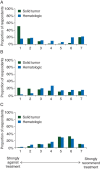Differences in attitudes and beliefs toward end-of-life care between hematologic and solid tumor oncology specialists
- PMID: 26041765
- PMCID: PMC4855240
- DOI: 10.1093/annonc/mdv028
Differences in attitudes and beliefs toward end-of-life care between hematologic and solid tumor oncology specialists
Abstract
Background: Patients with hematologic malignancies often receive aggressive care at the end-of-life. To better understand the end-of-life decision-making process among oncology specialists, we compared the cancer treatment recommendations, and attitudes and beliefs toward palliative care between hematologic and solid tumor specialists.
Patients and methods: We randomly surveyed 120 hematologic and 120 solid tumor oncology specialists at our institution. Respondents completed a survey examining various aspects of end-of-life care, including palliative systemic therapy using standardized case vignettes and palliative care proficiency.
Results: Of 240 clinicians, 182 (76%) clinicians responded. Compared with solid tumor specialists, hematologic specialists were more likely to favor prescribing systemic therapy with moderate toxicity and no survival benefit for patients with Eastern Cooperative Oncology Group (ECOG) performance status 4 and an expected survival of 1 month (median preference 4 versus 1, in which 1 = strong against treatment and 7 = strongly recommend treatment, P < 0.0001). This decision was highly polarized. Hematologic specialists felt less comfortable discussing death and dying (72% versus 88%, P = 0.007) and hospice referrals (81% versus 93%, P = 0.02), and were more likely to feel a sense of failure with disease progression (46% versus 31%, P = 0.04). On multivariate analysis, hematologic specialty [odds ratio (OR) 2.77, P = 0.002] and comfort level with prescribing treatment to ECOG 4 patients (OR 3.79, P = 0.02) were associated with the decision to treat in the last month of life.
Conclusions: We found significant differences in attitudes and beliefs toward end-of-life care between hematologic and solid tumor specialists, and identified opportunities to standardize end-of-life care.
Keywords: chemotherapy; decision making; end-of-life care; hematologic neoplasms; palliative care; quality of healthcare.
© The Author 2015. Published by Oxford University Press on behalf of the European Society for Medical Oncology. All rights reserved. For permissions, please email: journals.permissions@oup.com.
Figures

References
-
- Fadul NA, El Osta B, Dalal S, et al. Comparison of symptom burden among patients referred to palliative care with hematologic malignancies versus those with solid tumors. J Palliat Med 2008; 11: 422–427. - PubMed
-
- Manitta VJ, Philip JA, Cole-Sinclair MF. Palliative care and the hemato-oncological patient: can we live together? A review of the literature. J Palliat Med 2010; 13: 1021–1025. - PubMed
-
- Earle CC, Neville BA, Landrum MB, et al. Trends in the aggressiveness of cancer care near the end of life. J Clin Oncol 2004; 22: 315–321. - PubMed
Publication types
MeSH terms
LinkOut - more resources
Full Text Sources
Other Literature Sources
Medical

